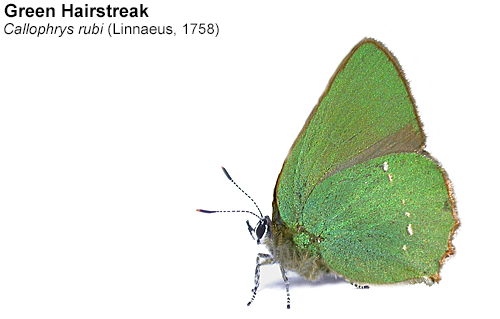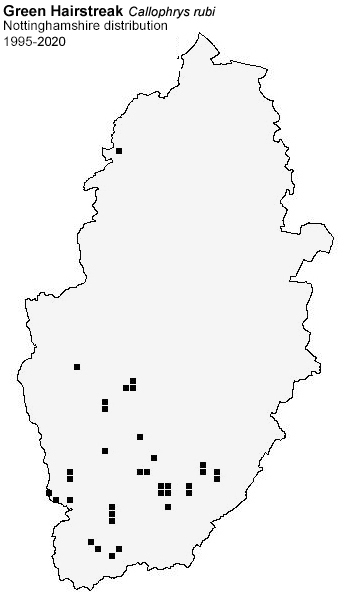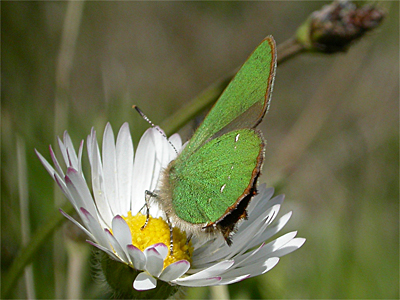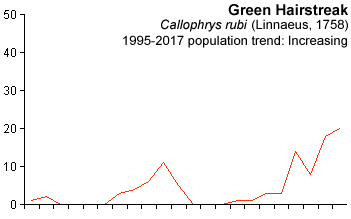

| The Green Hairstreak in Nottinghamshire |
| .... |
| Over the past thirty
years or so, this delightful butterfly has (thankfully) become a
Nottinghamshire resident once again. But, as you will have gathered
from the opening sentence, this hasn't always been the case and the
history of the Green Hairstreak in Nottinghamshire has really been a
tale of two halves. Presently (early May 2021) the Green Hairstreak is just coming on the wing in Nottinghamshire, which is quite late for this typically early Spring butterfly, but not unheard of and it has been recorded emerging as late as the third week of May. Although now well established after its return to the county, from personal experience, this is not an entirely easy species to find, even where you know it is. But if everything was easy, there would be no fun in it would there? |
 |
|
| ... | ||
|
Historical
records of Green
Hairstreak in Nottinghamshire J.W. Carr describes this species as 'rare and local' in opening his species summary. He goes on to list few actual records, but writing in the Entomologists Weekly, W.H. Smith reported it from 'in the immediate vicinity of Nottingham in 1859'. |
||||||||||||||||||||||||||||||||||||||||||||||||||||||||||||||||||||||||||||||||||||||||||||||||||||||
| ... | ||||||||||||||||||||||||||||||||||||||||||||||||||||||||||||||||||||||||||||||||||||||||||||||||||||||
 |
Carr does then goes on to list the following records, starting with 'once taken in Sherwood Forest' (Sterland) and 'along the brook near Edwinstowe, common every year' (Hardy). Brameld adds 'in the years 1858-1860, I took T. rubi plentifully in the woods about Mansfield'. Interestingly, Brameld uses the butterfly's former scientific name of Thecla rubi, rather than Callophrys rubi. Carr ends with records from 'Langford Moor near Newark, some seasons quite common' and 'occurs at Theives Wood, but very sparingly' (Daws); who in Carr's later Supplement relates that 'after an absence of many years, it turned up again in May 1920, in its old locality at Thieves Wood near Mansfield'. Current
distribution and status The sites mentioned by Carr are all in the northern half of Nottinghamshire, apart from that reported by W.H. Smith (not believed to be the famous retailer of the same name). Aside from two records at Carlton Wood near Worksop in 2015 and 2016, the Green Hairstreak is very much a butterfly of southern Nottinghamshire. But it is an improving picture for this particular butterfly, as it appears to heve been slowly increasing its range for a number of years, although its recent history has been rather 'unusual' shall we say.It was recorded from three sites (including a Cotgrave garden) in 1995 and 1996, but not reported again from anywhere in the county, until it suddenly appeared at Bestwood CP and the neighbouring former Bestwood Sand Quarry in 2002. It remained at Bestwood for a number of years, but seems to have disappeared and has not been reported from there since 2006 and failed to turn up in two specific searches for it in the last couple of years, the most recent being in May 2021. Having said that, Green Hairstreaks are one of the more difficult species to watch in flight and are easily missed, so it could well be at Bestwood as it has turned up at a private site adjacent to Bestwood Sand Quarry in the last year or so. |
|||||||||||||||||||||||||||||||||||||||||||||||||||||||||||||||||||||||||||||||||||||||||||||||||||||
| ... | ||||||||||||||||||||||||||||||||||||||||||||||||||||||||||||||||||||||||||||||||||||||||||||||||||||||
|
||||||||||||||||||||||||||||||||||||||||||||||||||||||||||||||||||||||||||||||||||||||||||||||||||||||
| ............... | ||||||||||||||||||||||||||||||||||||||||||||||||||||||||||||||||||||||||||||||||||||||||||||||||||||||
| In 2005, there were
numerous Green Hairstreak reports from Rushcliffe CP, but
just one report from 2006. It has not been reported from
the site since and after another three years with no
Nottinghamshire records, it turned up at Cotgrave CP
(formerly Cotgrave Colliery) between 2010 and 2014, with
an additional record from there in 2017. In 2014, it was found at Toton Sidings and there have been many Green Hairstreak records from this well visited location, where it continues to be reported from. Similarly, it has been present at the Nottinghamshire Wildlife Trust's Skylarks NR at Holme Pierrepont since 2014 and this remains one of the best places to see it. In the past few years, it has also appeared at Gedling CP (formerly Gedling Colliery), at nearby Netherfield Lagoons in 2016 and 2017 and at Bramcote in 2017. There is an unusual pattern to the Green Hairstreak's occurrence at most Nottinghamshire sites. For some inexplicable reason, it seems unable to survive at a site for more than a few years and the complete lack of records for periods of four years (1998 to 2001) and three years (2007 to 2009) are worrying. |
 |
| ...... | ||
 |
It could prompt the case for suggesting the possibility of failed captive-bred releases, although the butterfly's Nottinghamshire range is one which would be expected from a natural recolonisation. Flight period/when to see There is just a single brood each year. Most adults probably emerge at the end of April or early May, but there are several years when butterflies weren't reported until the third week of May. It is difficult to give an accurate picture of the butterfly's flight period, based on the limited number of available records. Generally, the flight season is quite short and over by early June, with an obvious peak around the middle of May. In 2016, inclusive dates for Green Hairstreak at Toton Sidings, were April 19th to June 6th. |
|
| ...... | ||
| Butterflies |
| Homepage |